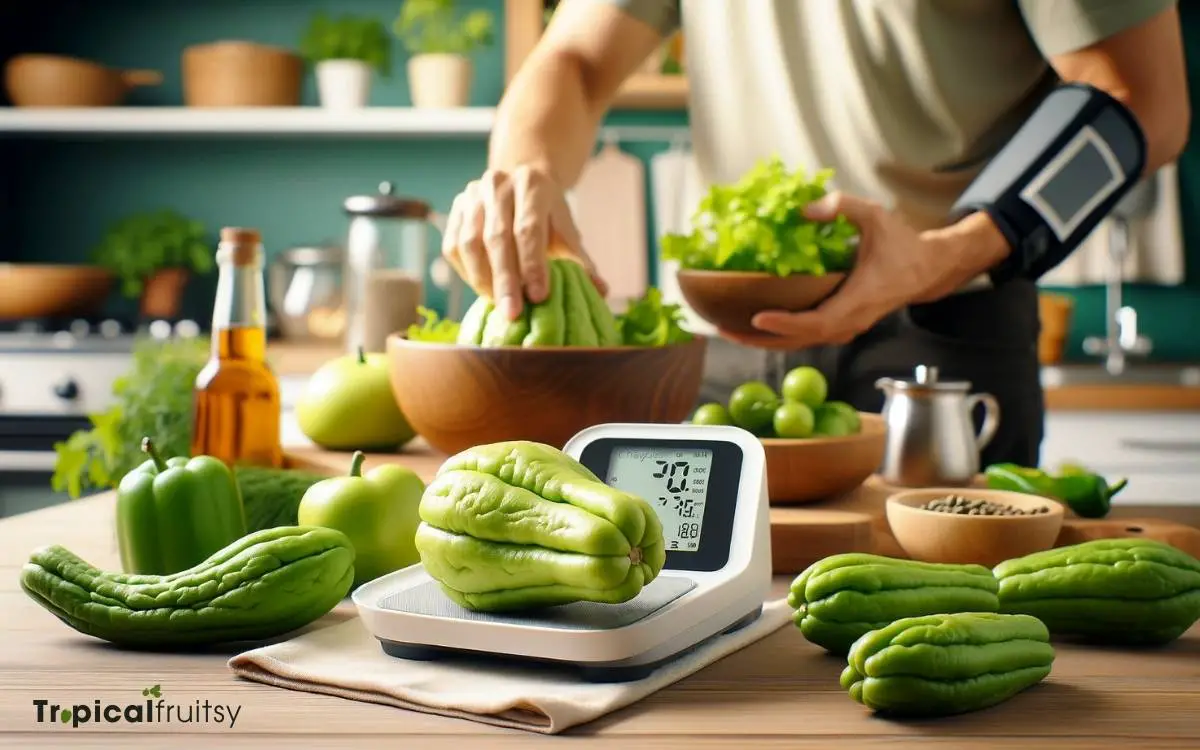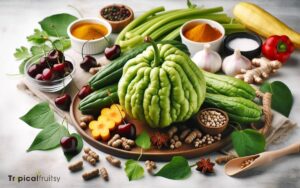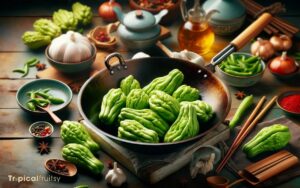How to Prepare Chayote for High Blood Pressure? 7 Steps!
Chayote, also known as vegetable pear, can be a beneficial food for individuals managing high blood pressure. Rich in potassium and low in sodium, it can be an excellent component of a heart-healthy diet.
To prepare chayote effectively, start by selecting firm, unblemished fruits. Wash them thoroughly under running water before peeling or slicing as desired.
Chayote can be eaten raw, steamed, boiled, or sautéed. When cooking, avoid using excess salt to maintain its low-sodium benefit. Instead, opt for herbs and spices to flavor the dish.
Incorporating chayote into meals can help in maintaining a balanced diet and potentially aid in blood pressure control.
Chayote is beneficial for high blood pressure due to its high potassium content, which helps balance the negative effects of sodium.
Steps to prepare it include:
For example, steaming chayote retains most of its nutrients and is a salt-free cooking method.
Discover the heart-healthy benefits of chayote in your diet, perfect for managing blood pressure naturally.

Key Takeaway
Understanding Chayote’s Nutritional Profile
Chayote, a type of squash, is rich in potassium and magnesium, nutrients essential for maintaining healthy blood pressure levels.
These minerals play a key role in cardiovascular health by regulating fluid balance and relaxing blood vessel walls, thereby reducing the risk of hypertension and associated complications.
Additionally, chayote is a low-calorie food with a high water content, making it an excellent choice for those managing weight, which is closely linked to blood pressure control.
Its fiber content also supports digestive health and can contribute to the feeling of fullness, which is beneficial for weight management.
As we consider the importance of incorporating chayote into a heart-healthy diet, let us now turn our attention to selecting the perfect chayote.
Step 1: Selecting the Perfect Chayote
In the pursuit of a heart-healthy diet, choosing a firm, unblemished chayote with vibrant green skin ensures maximum nutritional benefits for managing high blood pressure.
To select the best produce, consider the following:
- Appearance: Look for chayotes with a consistent green color, avoiding any with brown spots or signs of wilting.
- Firmness: Gently squeeze the chayote; it should feel solid and not give under slight pressure.
- Skin Texture: The skin should be smooth with minimal blemishes, which can indicate freshness and quality.
- Size: Opt for medium-sized chayotes, as they tend to have the best texture and flavor balance.
Selecting chayote with care not only contributes to the enjoyment of your meals but also optimizes the health advantages for managing your blood pressure.
Step 2: Washing and Peeling Techniques
Prior to consumption or cooking, proper washing and peeling of chayote ensure the removal of potential contaminants while preserving its valuable nutrients that can aid in managing high blood pressure.
Utilizing safe peeling methods minimizes the risk of nutrient loss and ensures that the maximum health benefits of the vegetable are retained.
Adhering to cleanliness best practices throughout the preparation process supports overall food safety and contributes to the health and well-being of individuals with hypertension.
Safe Peeling Methods
Proper handling techniques, including thorough washing and careful peeling, are essential to safely prepare chayote for consumption, particularly for individuals managing high blood pressure.
To ensure the chayote is prepared safely and retains its beneficial nutrients, follow these steps:
- Rinse the Chayote: Hold the chayote under cool, running water while gently scrubbing its surface to remove any dirt and potential contaminants.
- Dry Before Peeling: Pat the chayote dry with a clean towel to reduce slipping while peeling.
- Peel Carefully: Use a vegetable peeler or a sharp knife to remove the skin, taking care not to remove too much of the flesh, which contains valuable nutrients.
- Handle Safely: To avoid injury, peel away from your body and keep your fingers clear of the blade.
Cleanliness Best Practices
To maintain the highest standards of cleanliness, adopt meticulous washing and peeling techniques when preparing chayote for individuals with high blood pressure.
Begin by thoroughly rinsing the chayote under running water to remove any surface contaminants. Utilizing a vegetable brush can aid in dislodging dirt and potential pesticides.
Peeling the chayote not only removes the inedible skin but also any residual substances that rinsing alone might not eliminate. It’s imperative to use a clean peeler or knife to avoid introducing new contaminants.
For those with hypertension, ensuring the chayote is free from harmful bacteria and chemicals is crucial as it contributes to a heart-healthy diet.
With cleanliness assured, the next step is mastering the cutting and preparing basics.
Step 3: Cutting and Preparing Basics
Once the chayote is washed and peeled, it is essential to employ safe slicing techniques to maintain its nutrient integrity and ensure consumer safety.
Proper cutting methods help in preserving the beneficial properties of chayote, such as its potassium content which is vital for managing blood pressure.
Peeling Techniques
Before cooking chayote as a dietary approach to manage high blood pressure, it is essential to master the peeling technique, which involves removing the thin skin without compromising the flesh.
Proper preparation of chayote preserves its rich nutrients, such as potassium and fiber, which contribute to blood pressure regulation.
Here is a clear, step-by-step guide to peeling chayote:
- Wash the Chayote: Thoroughly rinse it under cold water to remove any surface dirt or pesticides.
- Dry and Stabilize: Pat the chayote dry, then place it on a cutting board to ensure it doesn’t slip.
- Slice Carefully: Cut the chayote in half lengthwise, then remove the seed if desired.
- Peel the Halves: Using a vegetable peeler, gently peel away the skin from each half, preserving as much of the flesh as possible.
This method helps maintain the integrity and nutritional value of the chayote, optimizing its health benefits.
Slicing Safely
After successfully peeling the chayote, the next critical step is to slice it safely and efficiently, ensuring even cooking and maximum nutrient retention. To begin, stabilize the chayote on a flat surface to prevent slipping.
Using a sharp knife, cut the chayote in half, and then into uniform slices or cubes, depending on your recipe. Uniformity is key for consistent texture and flavor during cooking.
Moreover, careful slicing helps to preserve the beneficial phytonutrients and vitamins, such as vitamin C, that can be sensitive to heat and handling.
It’s also important to keep your fingers tucked away while slicing to avoid injury. With your chayote sliced properly, you are now ready to explore cooking methods that further retain its valuable nutrients for those managing high blood pressure.
Step 4: Cooking Methods to Retain Nutrients
Selecting appropriate cooking methods is crucially important to preserve the nutritional profile of chayote, which benefits individuals managing high blood pressure.
To maintain its valuable nutrients, consider the following approaches:
- Steaming: This method helps retain vitamins and minerals without the need for added fats or oils. Studies suggest steaming can preserve the antioxidant properties of vegetables.
- Sautéing: Use a small amount of heart-healthy oil, such as olive oil, to quickly cook chayote, preserving its texture and nutrients.
- Blanching: Briefly boiling chayote and then plunging it into cold water can help maintain its crispness and nutrient content.
- Raw Consumption: Eating chayote raw ensures all nutrients are intact, offering the most direct benefit for blood pressure management.
Step 5: Seasoning Ideas for Low Sodium Diets
Incorporating a variety of herbs and spices can enhance the flavor of chayote without increasing sodium intake, an essential consideration for those managing high blood pressure.
Utilizing fresh or dried herbs such as cilantro, basil, and oregano can impart a robust flavor profile. Spices like cumin, coriander, and paprika offer depth and warmth without the need for salt.
For a citrusy zest, consider adding a squeeze of lime or lemon juice, which can brighten the dish and promote vascular health due to their antioxidant properties.
Garlic and onion powders are excellent for creating a savory taste, while avoiding the potential blood pressure-raising effects of excessive salt consumption.
Step 6: Delicious Chayote-Based Recipes
Within the framework of a heart-healthy diet, chayote can be transformed into a variety of delectable dishes that cater to individuals with high blood pressure.
Here are some nutrient-rich recipes:
- Chayote Squash Salad: Toss thin slices of raw chayote with a dressing of olive oil, lemon juice, and a pinch of salt substitute for a refreshing and potassium-rich starter.
- Sautéed Chayote with Garlic: Lightly sauté chayote cubes with garlic in olive oil, adding herbs like thyme to enhance flavor without excess sodium.
- Stuffed Chayote: Bake halved chayote with a filling of cooked quinoa, black beans, diced tomatoes, and a sprinkle of low-sodium cheese.
- Chayote Soup: Simmer chayote chunks in a low-sodium vegetable broth with onions, celery, and carrots for a heartwarming soup.
These recipes not only manage blood pressure but also offer a symphony of flavors. Next, we’ll explore how to seamlessly incorporate chayote into daily meals.
Step 7: Incorporating Chayote Into Daily Meals
How can one seamlessly integrate chayote into their daily diet to help manage high blood pressure?
This versatile fruit, rich in potassium and low in sodium, is ideal for supporting cardiovascular health.
Studies suggest that a diet abundant in potassium can help to reduce hypertension by balancing the effects of salt in one’s diet and easing tension in the blood vessel walls.
Begin by incorporating chayote into salads or substituting it for high-carbohydrate vegetables like potatoes. Its mild flavor makes it an excellent addition to smoothies or as a cooked side dish.
For those monitoring caloric intake, chayote’s low calorie content is beneficial. Furthermore, its fiber content aids digestion and promotes satiety, which can prevent overeating—key for weight management, often linked to blood pressure control.
Conclusion
Chayote, much like a sponge absorbing water, has the capacity to soak up an array of nutrients beneficial for managing hypertension.
Its low sodium content and rich profile of vitamins and minerals make it an ideal choice for those monitoring blood pressure.
By incorporating chayote into one’s diet through various cooking methods and recipes, individuals may embrace a heart-healthy lifestyle, replete with the flavors and benefits this versatile vegetable has to offer.






